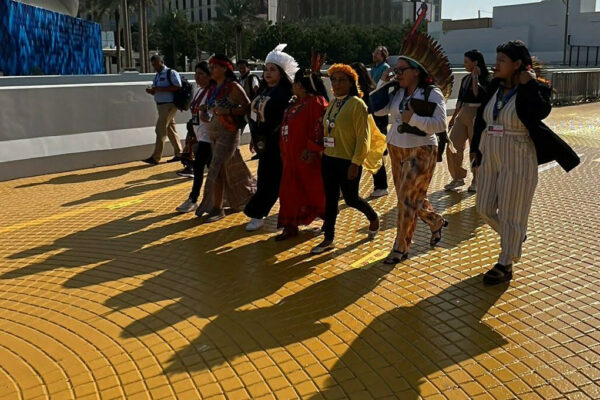The pilot tried for the third time to land the plane. Wind and rain lashed us from all sides. The plane swayed a bit, then banked sharply to the left and dropped. But this time we made it.
There were no runway lights, no radar, no instrument landing system and, to be frank, no real runway – just a long clearing surrounded by thick jungle.
Later the young pilot would tell us the first two attempts get the plane down failed because he could not see the runway.
That was comforting and I was glad he made that admission when we were on terra firma.
After a trip that had started 48 hours earlier in Washington DC, we had arrived in the land of the Sarayaku, deep in the Ecuador’s Amazon region.
“Let’s get out of this tin can,” cameraman Steve Harper said, his face slowly recovering its normal colour after the plane stuttered to a stop at the far end of the clearing.
The “tin can” he was referring to was the small, single-engined five-seater that had brought us here from the grimy oil town of Coca about two hours away.
There was a small reception committee waiting for us. Chief Jose Gualinga was in full tribal regalia, with his face painted, and other tribal elders were on hand to welcome us to their remote village.
Self-contained life
The Sarayaku [meaning “River of Corn”] are a native people who live in several villages along a stretch of the Bobonaza river in the province of Pastaza in the southern part of the Ecuadorean Amazon.
They number about one to two thousand and lead a frugal, self-contained life. Everything they eat is produced here. Their main sources of income are farming, hunting, fishing and eco-tourism.
For the last 100 years, very little has changed in their way of life. They grow their own food in neaby jungle tracts – mainly yams and corn – and live in simple homes sitting on stilts made with broad wood beams covered with thatch walls and roofs.
Children study the indigenous Kichwa langauge. Women do all the farming and cooking – and almost everything else. A council of elders presides over an assembly of 200 members which meets twice yearly to discuss issues affecting the group. It’s about as carefree as it gets.
But all that is now being threatened. The threat is oil. Lots of it. And, unfortunately for them, it sits right under their ancestral lands.
The Ecudorean government and Big Oil want to exploit these reserves, but the Sarayaku fear that any attempt to drill on their land would – in the words of Chief Gualinga – “destroy their unique way of life”.
So they are mounting a vigorous human-rights campaign to keep the oil companies out.
Al Jazeera producer Tom Szypulski, cameraman Harper and I were there to get their side of the story.
After the welcome formalities, we were shown to our quarters, three neat single-person tents with colourful, folded blankets placed outside the entrance flaps. Not quite sleeping under the stars but pretty close to it. The rain had steadied to a persistent drizzle.
Harper hoisted the camera onto his shoulder and we wandered around the village followed by a small ground of giggling girls and boys. We visited the small school where kids sat squeezed up on on long benches. We stood in the rain and talked with the villagers.
They wanted to know if Gaddafi was still alive and whether Castro was dead. Then we sailed a short way upstream in a very unstable dugout to the main village and made our way over a field of thick, deep mud to the cavernous auditorium where the people’s assembly meets.
PowerPoint presentation
We watched a lengthy PowerPoint presentation powered by a quiet generator about the Sarayaku complete with maps, slides and graphs [Microsoft has quietly slipped in there].
When a break in the clouds brought the sun out, we paddled back, going downstream where a lunch of boiled chicken and corn awaited us.
Later, in the dying embers of an Amazon afternoon, we shot an outdoor interview with Chief Gualinga.
He acknowled his people were poor and and the region was under-developed, but he was adamant that oil was not going to fix that: “One cannot fight poverty by destroying nature. It is not good policy, it is not logical.
“It is not scientific. It is not technical. And it is not democratic. Poverty in Ecuador should be fought in a way in which resources are used wisely … Ecuador is an exporter of petroleum but that does not mean the whole Amazon should be turned into a petro-zone.”
But, as one would expect, the government sees it very differently. It issued a statement through the Ecuador attorney general’s office which said Ecuador believes there should be a balance between the good of society and the good of one particular group.
It said it respects and would protect the interests of any indigenous community, but would not allow any group to impose its will on the entire nation. So, here in the idyllic surrounds of the Amazon jungle, the battle lines are drawn.
Faced with what they see as an existential threat, the Sarayaku have taken their case to the Inter-American Court of Human Rights, which sits in Costa Rica. The court has heard testimony from both sides in this dispute and is expected to issue a ruling later this year. An entire people’s future will depend on it.
We rose the next morning with the roosters and after a light breakfast – more corn – we made our way through the thick wet grass to the clearing, where the same single-engine plane that we’d arrived in was waiting to take us back.














